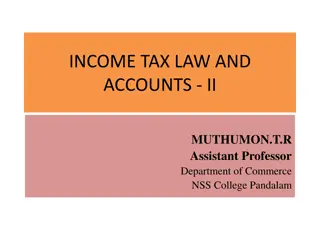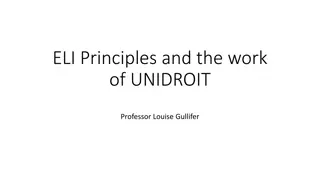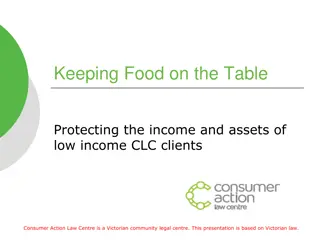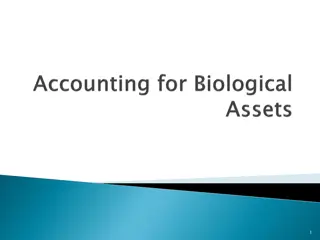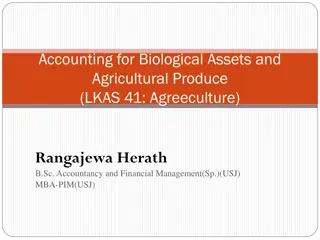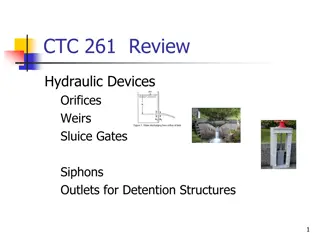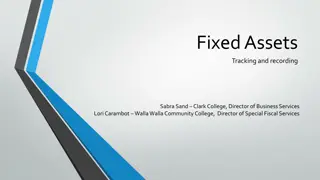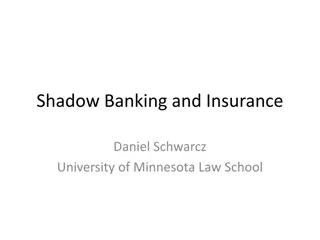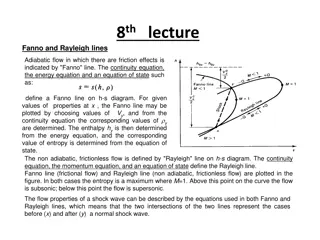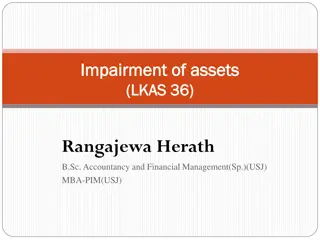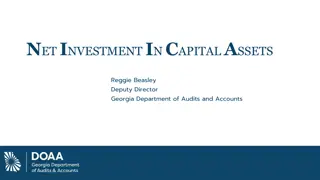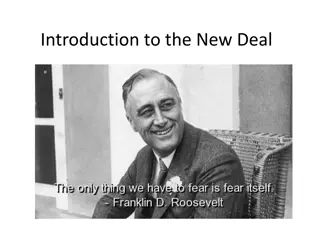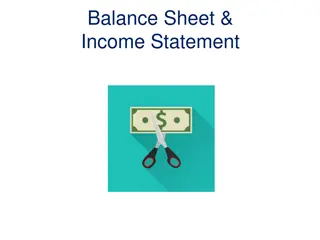Optimal Deal Flow for Illiquid Assets
It is important to combine quantitative rigor with on-the-ground experience in illiquid asset investing for optimal deal flow. The investment process varies for investors, facing challenges such as unknown investable universe and bidding asymmetry. Overpaying in bids can lead to reduced returns, increased uncertainty, and higher risk. Striking the right risk-adjusted limit is crucial for successful illiquid asset investment.
Download Presentation

Please find below an Image/Link to download the presentation.
The content on the website is provided AS IS for your information and personal use only. It may not be sold, licensed, or shared on other websites without obtaining consent from the author. Download presentation by click this link. If you encounter any issues during the download, it is possible that the publisher has removed the file from their server.
E N D
Presentation Transcript
Optimal Deal Flow For Illiquid Assets Emilian Belev, CFA and Richard Gold QWAFAFEW September 15, 2015
Why this is important It has been a de-facto rule that the real estate investment process has been siloed away from most widely accepted quant practices Two schools of thought bring unique core competencies to the table: Quant: Rigor of estimation and aggregation to overall risk Fundamental: On-the-ground experience with the fundamentals of illiquid asset investing Combining the two will produce multiple benefits to the quality of the illiquid asset investment process Slide 2 www.northinfo.com
The Illiquid Asset Investment Process Investment process varies from investor to investor: Single purpose investor focused by land use, geography, and/or strategy Larger investor needs more flexible and may require possibly some formal queuing system for allocating deals across funds Regardless of size, all investors face the same problem: The investable universe at any given time is unknown. Investors receive investment deals based on their size, previous activity, reputation - even the largest and most active do not see every deal Capital market and economic conditions affect deal flow: during downturns because deals are withheld; during booms bidding wars decrease decision time Makes it difficult to rebalance portfolio in a timely and efficient manner Slide 3 www.northinfo.com
Illiquids Investment Process: Bidding Asymmetric bidding between buyers and sellers over a differentiated product (the illiquid asset) creates incentives to overpay: Little time for buyer to contemplate the impact of a revised upward bid Behavioral biases win the bid rather than invest well Reputation managers have limited time to invest on behalf of sponsors REITs legal implications to stay invested Slide 4 www.northinfo.com
Illiquids Investment Process: Bidding (contd) A winning bidder that has overpaid has: Reduced potential return Simultaneously increased the uncertainty of the size of loss Potential increased correlation with other assets: due to pervasive bias from pressure to win and stay invested as a matter of investment practice Losers are forced to move down food chain , with more pressure to add lesser assets at higher prices taking on more risk for less reward STRIKING THE BALANCE: Setting the correct risk-adjusted upper limit is paramount for the illiquid asset investment process Slide 5 www.northinfo.com
ODFI - The Tools (1) Fundamental: Knowledge, or reasonable expectation, of the fundamental of individual deals in the deal flow, to estimate NPV (2) Quant: Basic Portfolio Theory to capture the incremental impact of proposed investment deals to existing portfolio volatility (3) Quant: Real option analysis to estimate the expected downside impact of the new asset to portfolio performance (4) Fundamental: Capital budgeting, using expected marginal benefit of the particular deals Slide 6 www.northinfo.com
Step 1: Calculating baseline NPV of new deals Estimating Net Operating Income (NOI) is the bread-and-butter of brick-and-mortar experts When discounting, we use the risk-free rate The reason: we will be subtracting explicitly the expected impact of downside performance from baseline NPV to get to risk-adjusted NPV. Fundamental Theorem of Asset Pricing: This will have identical effect to NPV as calculating a cap rate and using it instead of the risk-free rate Slide 7 www.northinfo.com
Step 2: Estimating Incremental Volatility A tenet of Portfolio Theory is that an asset should always to be analyzed in light of its impact on the portfolio, and not in isolation Therefore we are concerned not with the standalone volatility of the new asset, but with its impact to the existing portfolio Given a risk model that transcends liquid and illiquid asset classes, calculation of the incremental impact of a new asset, or combination of new assets, is a simple algebraic exercise: The difference of portfolio volatility with and without the new assets The risk model has to be global and across-asset class because the existing portfolio is global and across-asset class, so incremental impact is captured appropriately. Slide 8 www.northinfo.com
Modeling Illiquids Northfield models illiquids using a bottom-up asset-by-asset approach that is not appraisal-based Each investment is viewed as a composite asset with: Risks based on steady-state cash flow assumptions for existing and expected leases/sources of cash flows Uses lease structure, renewal, credit quality of tenants, vacancy dynamics, revenue and expense schedules Risks related to mortgage financing (if any) Takes into consideration floating rate, fixed rate, interest-only, balloon clauses, prepayment behavior, etc. Risks of future fluctuations in market rents/contractual obligations Takes into consideration the combined impact of lease rollover, vacancy, renewal, and market volatility of rents Each component has risk exposures to common risk factors plus idiosyncratic risks Slide 9 www.northinfo.com
Northfields Private Equity Model (cont) MORTGAGE FINANCING (SHORT) RENT/CONTRACTAL OBLIGATION VOLATILITY STEADY STATE CASH FLOW (LONG) TIME VALUE OF MONEY CHANGE IN RENT CREDIT RISK RISK FACTORS RISK FACTORS RISK FACTORS GLOBAL RISK MODEL PORTFOLIO RISK Slide 10 www.northinfo.com
Example: Real Estate Model Results Risk Profile: A Sample US Apartment Building Risk by Source 16.1% 5.1% 3.9% Interest Rate Risk Rent Risk Credit Risk XX% 17.3% Total Risk Slide 11 www.northinfo.com
Step 3: Estimating Downside Impact Merton real option analysis has been in existence for while and with a wide range of applications from analysis of firms to credit. The key idea: Debt level to which we measure loss a strike price Underlying the collateral with its volatility and value Estimation done with an option pricing model In the same spirit, but different setting, we can use Offer Price level to which we measure loss a strike price Underlying the illiquid assets future cash flows with their volatility and present value Estimation done with an option pricing model Slide 12 www.northinfo.com
Step 3: Estimating Downside Impact (contd) A buyer in an investment is short a put on the asset underperformance, which the seller of the investor is long. Treat the incremental volatility as the effective volatility of the asset underlying the put. The strike price of the put is the offer price for the new asset ????????= 2 2 ???? ?????????? ???? ?????????? +2???????? ????.???? ?????????? ?????? ??????????,??????? ????. ???? ?????????? The result is the dollar value an investor assigns to the estimate downside impact. Option theory agrees with intuition the higher the offer price (put strike) the higher the downside potential and risk. Also, the higher the (incremental) volatility the higher the downside risk. Slide 13 www.northinfo.com
Step 4: Calculating Risk-Adjusted NPV Subtract the value of the loss-related put from the baseline NPV We perform steps 1-4 for all assets and combination of assets that sum to or less than the budget constraint. Combinations should potentially include some cash, and should not have an overlap of assets included in them The sum of all asset and combinations in any decision making cycle (usually a week to a month) and within constraint of investable cash per investment portfolio is usually in the vicinity of 10-20 Modern technology makes the turnaround of all calculations involved in this process completely tractable Slide 14 www.northinfo.com
Step 5: Capital Budgeting We sort all investment possibilities by Risk-Adjusted NPV in descending order The cutoff point will be the acceptance threshold for possibilities Adj. NPV Capital Employed Accept Region Capital Constraint Slide 15 www.northinfo.com
Step 5: Capital Budgeting (contd) Increasing cost of capital due to borrowing will contribute to increasing present value of financing cash flows (discounted at the risk-free rate), presenting a dynamic capital constraint Adj. NPV Present Value of Financing (Variable Capital Constraint) Accept Region Capital Employed Slide 16 www.northinfo.com
ODFI in Practice Cumulative Budget Constraint Cumulative Investment CCA Drawdown Value per dollar invested Offer Price PV Cash Inflows (mill dollars) Adjusted NPV (per dollar invested) PV (per dollar Invested) NPV (per dollar Invested) Time Horizon Imputed Volatility Investment (mill dollars) (mill dollars) (mill dollars) Investment 3 (Office prop.) Investment 6 (Retail prop.) Investment 5 (Electric Distr.) Investment 3 (Timberland) Investment 1 (Farmland) 36.8 23.6 1.6 0.56 15 23.5 0.07 0.49 23.6 50 17.6 12.1 1.5 0.45 15 16.3 0.04 0.42 35.7 50 14.8 9.9 1.5 0.50 15 29.3 0.11 0.39 45.6 50 25.3 17.0 1.5 0.48 15 30.0 0.12 0.36 62.6 50 14.8 11.0 1.4 0.35 15 18.3 0.05 0.30 73.6 50 Investment 7 (Private Debt) 28.6 22.0 1.3 0.30 15 20.0 0.07 0.23 95.6 50 Investment 8 (Office prop.) Investment 2 (Warehouse) 11.0 8.8 1.3 0.25 15 15.8 0.05 0.20 95.6 50 23.6 20.9 1.1 0.13 15 15.0 0.05 0.08 95.6 50 Slide 17 www.northinfo.com
Optimal Objective: MVO vs. ODFI MVO Objective = ?? ??2 (ignoring the impact of a risk aversion coefficient) ??2 ?? 2?+ ODFI Objective = ??+ ? ?? 2?? 2? P is a p value under normal distribution corresponding to the cutoff region. This expression is more involved than MVO, as it recognizes the investment downside potential, in specific, and the interaction of the mean and volatility with the offer price. Slide 18 www.northinfo.com
Extensions to the ODFI Model The option-based ODFI model is particularly well suited to incorporate, the option to wait for the investor to invest. This relates to: The potential that frequency of offered deals changes in slower economies than booming economies Only cash-strapped owners will sell at depressed prices However the deals that would appear in a distressed market might offer better entry point for an investor and hence better payoff A liquidity probability distribution of outcomes can then be constructed conditional on the state of the economy and incorporated in the ODFI option pricing. Slide 19 www.northinfo.com
Summary For too long real estate deal selection has been tied up like Gulliver in regards to optimal investing: Agency problems and competitive bid situations have lead to no-win situations where winners and losers make suboptimal decisions due to lack of hard criteria Using a real estate risk model and fundamental inputs, ODFI allows users to quickly rank in rigorous fashion all available investment deals by their risk-adjusted NPV in descending order, and find the cut-off point that matches their capital budgeting constraints; The ODFI methodology (which unlike MVO is multi-period) is very well suited for the investment horizons of illiquid asset investors. It also offers the more intuitive measure of risk expected loss, and process capital budgeting, both of which are a good fit to the investment culture an practice in the field and thus improve the acceptance level. Slide 20 www.northinfo.com
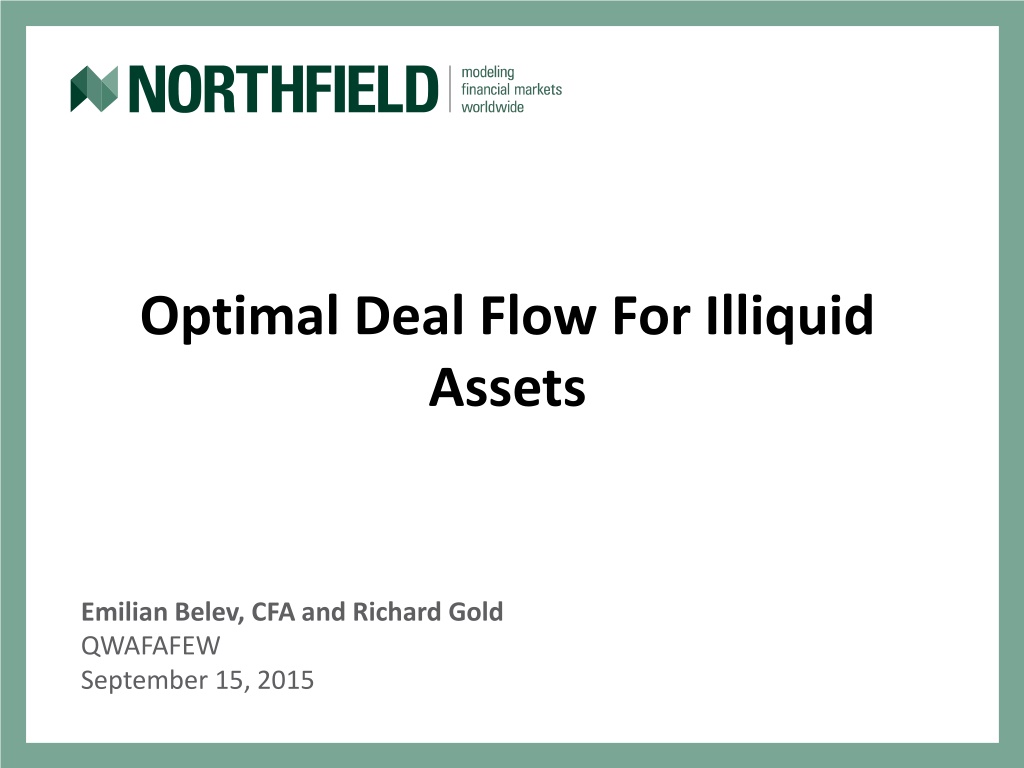
 undefined
undefined











